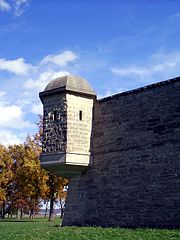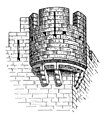Bartizan

Bartizan at Fort de Chartres, a French colonial era fort in Illinois on the Mississippi River.
A bartizan, (an alteration of bratticing), also called a guerite or échauguette, or spelled bartisan, is an overhanging, wall-mounted turret projecting from the walls of late medieval and early-modern fortifications from the early 14th century up to the 18th century.[1] Most frequently found at corners, they protected a warder and enabled him to see his surroundings. Bartizans generally are furnished with oillets or arrow slits.[2] The turret was usually supported by stepped masonry corbels and could be round, polygonal or square.[3]
Bartizans were incorporated into many notable examples of Scots Baronial Style architecture in Scotland. In the architecture of Aberdeen, the new Town House, built in 1868–74, incorporates bartizans in the West Tower.
Contents
1 Gallery
2 See also
3 References
4 External links
Gallery
Guarita at Fortaleza de Santiago, Sesimbra Municipality, Portugal.

Gardjola at the Spur, Senglea, Malta.

Garita at El Cañuelo in the Bay of San Juan, Puerto Rico.

South-East Bartizan on Greenknowe Tower, Scottish Borders (and another one in the background)

Line drawing of a bartizan

Bartizans on the West Tower of the new Town House in Aberdeen, Scotland, 1868–74.

Garita at Castillo San Cristóbal (San Juan) in San Juan, Puerto Rico.

A bartizan-style British concrete position built at the north-western corner of Sergei courtyard, Jerusalem. This is probably the sole existing testimony of the British "Bevingrad" constructed in 1946.

Modern Bartizan (Garitta) of a Carabinieri Station in Campobasso, Italy.

Devil's Sentry Box, or the "Garita del Diablo", San Cristóbal Castle, in San Juan, Puerto Rico.
Manueline Guaritas at Belém Tower in Lisbon, Portugal.

Bartizans at Feartagar Castle, Ireland.
See also
| Look up bartizan, bartisan, échauguette, or guerite in Wiktionary, the free dictionary. |
- bretèche
garret—an attic or top floor room in the military sense; a watchtower from the French word garite
References
^ One or more of the preceding sentences incorporates text from a publication now in the public domain: Wood, James, ed. (1907). "Bartizan". The Nuttall Encyclopædia. London and New York: Frederick Warne..mw-parser-output cite.citation{font-style:inherit}.mw-parser-output q{quotes:"""""""'""'"}.mw-parser-output code.cs1-code{color:inherit;background:inherit;border:inherit;padding:inherit}.mw-parser-output .cs1-lock-free a{background:url("//upload.wikimedia.org/wikipedia/commons/thumb/6/65/Lock-green.svg/9px-Lock-green.svg.png")no-repeat;background-position:right .1em center}.mw-parser-output .cs1-lock-limited a,.mw-parser-output .cs1-lock-registration a{background:url("//upload.wikimedia.org/wikipedia/commons/thumb/d/d6/Lock-gray-alt-2.svg/9px-Lock-gray-alt-2.svg.png")no-repeat;background-position:right .1em center}.mw-parser-output .cs1-lock-subscription a{background:url("//upload.wikimedia.org/wikipedia/commons/thumb/a/aa/Lock-red-alt-2.svg/9px-Lock-red-alt-2.svg.png")no-repeat;background-position:right .1em center}.mw-parser-output .cs1-subscription,.mw-parser-output .cs1-registration{color:#555}.mw-parser-output .cs1-subscription span,.mw-parser-output .cs1-registration span{border-bottom:1px dotted;cursor:help}.mw-parser-output .cs1-hidden-error{display:none;font-size:100%}.mw-parser-output .cs1-visible-error{font-size:100%}.mw-parser-output .cs1-subscription,.mw-parser-output .cs1-registration,.mw-parser-output .cs1-format{font-size:95%}.mw-parser-output .cs1-kern-left,.mw-parser-output .cs1-kern-wl-left{padding-left:0.2em}.mw-parser-output .cs1-kern-right,.mw-parser-output .cs1-kern-wl-right{padding-right:0.2em}
One or more of the preceding sentences incorporates text from a publication now in the public domain: Wood, James, ed. (1907). "Bartizan". The Nuttall Encyclopædia. London and New York: Frederick Warne..mw-parser-output cite.citation{font-style:inherit}.mw-parser-output q{quotes:"""""""'""'"}.mw-parser-output code.cs1-code{color:inherit;background:inherit;border:inherit;padding:inherit}.mw-parser-output .cs1-lock-free a{background:url("//upload.wikimedia.org/wikipedia/commons/thumb/6/65/Lock-green.svg/9px-Lock-green.svg.png")no-repeat;background-position:right .1em center}.mw-parser-output .cs1-lock-limited a,.mw-parser-output .cs1-lock-registration a{background:url("//upload.wikimedia.org/wikipedia/commons/thumb/d/d6/Lock-gray-alt-2.svg/9px-Lock-gray-alt-2.svg.png")no-repeat;background-position:right .1em center}.mw-parser-output .cs1-lock-subscription a{background:url("//upload.wikimedia.org/wikipedia/commons/thumb/a/aa/Lock-red-alt-2.svg/9px-Lock-red-alt-2.svg.png")no-repeat;background-position:right .1em center}.mw-parser-output .cs1-subscription,.mw-parser-output .cs1-registration{color:#555}.mw-parser-output .cs1-subscription span,.mw-parser-output .cs1-registration span{border-bottom:1px dotted;cursor:help}.mw-parser-output .cs1-hidden-error{display:none;font-size:100%}.mw-parser-output .cs1-visible-error{font-size:100%}.mw-parser-output .cs1-subscription,.mw-parser-output .cs1-registration,.mw-parser-output .cs1-format{font-size:95%}.mw-parser-output .cs1-kern-left,.mw-parser-output .cs1-kern-wl-left{padding-left:0.2em}.mw-parser-output .cs1-kern-right,.mw-parser-output .cs1-kern-wl-right{padding-right:0.2em}
^ One or more of the preceding sentences incorporates text from a publication now in the public domain: Chisholm, Hugh, ed. (1911). "Bartizan". Encyclopædia Britannica. 3 (11th ed.). Cambridge University Press. p. 450.
One or more of the preceding sentences incorporates text from a publication now in the public domain: Chisholm, Hugh, ed. (1911). "Bartizan". Encyclopædia Britannica. 3 (11th ed.). Cambridge University Press. p. 450.
^ Bradley, Simon, ed. (2010). Pevsner's Architectural Glossary. Yale University Press. p. 33. ISBN 978-0-300-16721-4.
External links
| Wikimedia Commons has media related to Bartizans. |
This castle-related article is a stub. You can help Wikipedia by expanding it. |
This architecture-related article is a stub. You can help Wikipedia by expanding it. |













Comments
Post a Comment